Large Clean Sheds!
All the Nilus II loom models have large sheds making it easy to throw a shuttle through regardless of which size is used. They all have shuttle races in the beater mechanism but the design of the looms are optimized to provide a clear large path for the weaver to insert weft thread regardless of whether they are using a boat, stick, rag, end feed or flying shuttle.
The upper picture to the right is the size of the shed on the Nilus II 8 shaft Countermarch while the lower one is the Nilus II Jack loom with Back-Hinge Treadles.
The Countermarch and the Counterbalance mechanisms create a shed by both raising and lowering warp threads which means the amount of warp thread deflection required to create the same shed is half that required by the Jack mechanism which only raises warp threads. For that reason the shed on the two looms is large and easier to create. This fact and the use of the Back-Hinge Treadles on the Countermarch model makes it very, very easy to treadle but the tie-ups on the Jack loom are much simpler.
The Beater height on all Nilus II looms is adjustable to allow the weaver to position the warp in relation to the reed and the shuttle race to maximize the shed size.
|
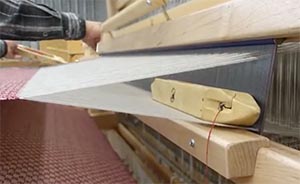
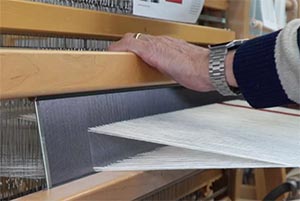 |
|
Triple Pawl Warp Advance System
To advance the warp and position the fell line where most comfortable to the weaver, a Take-up Motion handle located on the right side of the cloth beam is easily accessable to the weaver. A heavy duty metal pawl on the handle grips the ratchet wheel on the end of the cloth beam to turn it to wind the woven fabric onto the beam. To hold it in position while weaving a set of two metal pawls attached to the loom frame stop the cloth beam from turning in the opposite direction.
The unique Leclerc Triple Pawl system is designed in such a way that when the weaver stops advancing the warp, only one of the frame pawls engages with the ratchet to stop the beam from turning. This means that even though there are 20 teeth on the ratchet wheel, there are actually 40 positions the wheel can stop during a rotation. This design allows the weaver to more finely adjust the tension on the warp.
While it would have been easier and less costly to simply use a 40 tooth ratchet and one less pawl, the reduced height and thinner more shallow teeth would have greatly reduced the wheel's strength and would make it easier for the cloth beam to slip. You can see the Triple Pawl system in action and hear it's distictive metallic clink in this video.
As well as increasing the strength by using metal, the weight of the pawls allows them to use gravity to lock in place. It also means that once a project is finished, the weaver can simple flip the three pawls up out of the way and unroll the fabric off the free-turning cloth beam. It also makes cloth beam removal a cinch! |

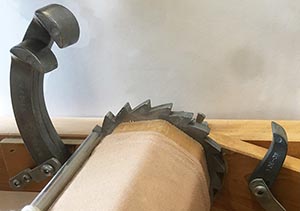
|
|
Leclerc Friction Brake
All Nilus II models come with the Leclerc Friction Brake system. The brake uses a flat metal band called a Brake Circle wrapped around a steel Brake Drum on the end of the Warp Beam. Contact between the two applies a tremendous amount of force to prevent the warp beam from turning. A light touch on the brake treadle by the weaver's right foot, while remaining seated at the loom, releases the tension allowing the warp beam to rotate. A small latch at the end of the brake treadle allows the brake to be locked in the released position while warping.
The Leclerc Friction Brake coupled with Leclerc's Triple Pawl Ratchet Warp Advance system enables the weaver to easily apply anything from a small to a very large amount of tension on the warp threads and Leclerc's unique Warp Beam Advance Control system stops the Warp Beam from unravelling the warp threads when the brake is released.
Unlike the Ratchet and Pawl mechanism used on some looms, the Leclerc Friction Brake allows the warp beam to be locked in an almost infinite number of positions rather than those dictated by the number of teeth on the ratchet wheel. The Friction Brake also eliminates the problem of ratchet wheel teeth breaking. When a large amount of tension is applied in a Ratchet/Pawl system, releasing the brake requires the pawl to be raised up along the ratchet wheel tooth, ultimately applying pressure to the weak narrow tip of the tooth which can cause it to snap off. Leclerc converted away from this type of brake back in the 1950's but it is still being used by some loom makers.
The heavy duty Steel Brake Drum and the special metal Brake Circle are much more expensive than the lower cost wooden brake drum and wire loop system or simple ratchet brake design other manufacturers use but produces a stronger, more durable, dependable and functional design which is why there are many Leclerc looms with their original friction brake still working hard after decades and decades of use! |

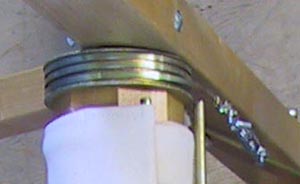 |
|
Warp Advance Control System
Located at the back of the loom on the left side, the Warp Advance Control system allows the weaver to add a variable amount of friction to the warp beam using a nylon screw mechanism. This control prevents the warp beam from spinning out of control, unwinding the warp when the brake is released suddenly and is especially useful when weaving a highly tensioned warp like that used for weaving rugs. The Warp Advance Control can be set up so that when the brake is released, the warp beam only rotates when the weaver advances the warp with the Take-up Motion Handle on the front right side making warp advances quick and easy. |
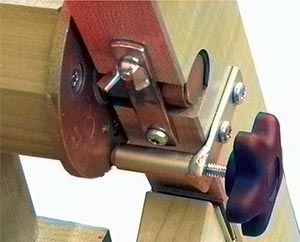 |
|
Beater/Reed Design
The reed for the Leclerc Nilus II loom is installed in the Beater between two horizontal beams called the "Batten Handtree" and the "Batten Sley". These 1 3/4 inch square Maple beams hold the Reed securely in position by sitting below and pressing down from the top. The Upper Batten Handtree is fastened with wingnuts that when loosened allow it to be raised to remove or change the reed. The space for the reed is not blocked on either the right or left side so the weaver to use a reed that is longer than the one made for this loom width by letting the extra length stick out on either side. Because Leclerc offers a wide range of their own Carbon and Stainless Steel Reeds Nilus II owners don't have to deal with the frustration of searching to find something to fit their loom.
On Nilus II models, the Batten Sley has an additional piece of wood attached to it called the "Shuttle Race". Fastened on an angle, it provides a solid base for the lower warp threads to help support the shuttle on its path through the shed. Though technically only needed on a Jack loom, Leclerc includes this on all Nilus II models. It is held on using a set of screws and can be removed if the weaver does not want to use it.
The optional Raddle Leclerc makes is designed with the same profile as the reed to allow it to be installed and held in the beater during the threading process. It can also be mounted to the front or back beams of the looms using a set of metal clips that are included.
Depending upon the particular mechanism used by the loom (ie. Counterbalance, Countermarch, Jack), the vertical position of the warp threads as they travel through the reed is important for optimal loom operation and maximum shed size. Leclerc makes this easy to adjust using a set of Mounting Plates at the bottom of the Beater Swords on the Jack and Counterbalance models. By undoing the pair of bolts, the beater can be raised or lowered to position the reed and shuttle race in relation to the warp. Tightening the pair of bolts on each side locks the beater height.
The Nilus II Counterbalance model also lets the warp threads be positioned but does so dynamically using the Shed Regulator mechanism built into the loom which lifts and lowers the warp threads based on the shafts being used each pick.
|
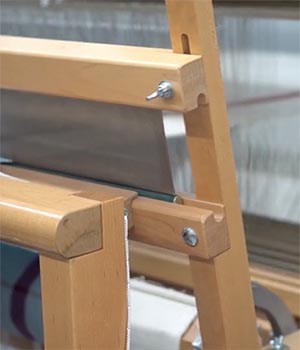
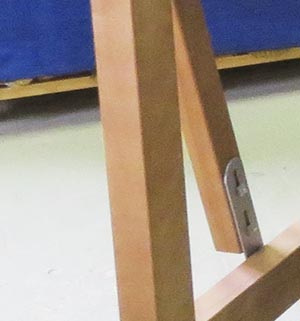 |
|
Easy Access for Threading
The front and back beams of the loom can be lifed off and set aside to make it easier to access the warp/cloth beams and shafts while threading the loom. During weaving the warp tension applies pressure to prevent them from moving eliminating the need to undo bolts or screws. In addition, the cloth beam can be easily removed by undoing two wing nuts and sliding the locking plates out of the way. The Beater and Reed can also be removed by undoing 4 bolts. The warp beam can also be removed by releasing the brake circle and undoing and opening the locking plates holding it in place.
This accessability allows the weaver to sit right in the loom either from the back or the front depending upon what threading method they use. When finished and the warp is ready, they can then quickly put everything back in place.
Removing the Front Beam and Beater
Removing the Back Beam and Warp Beam |

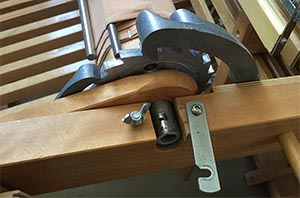 |
|
Leclerc Tie-up System
The Leclerc Tie-up system is designed to make the process easier. Instead of having the weaver tie knots under the loom and fine tune cord lengths, the connection between the lamms and the treadles is made with fixed length Treadle Cords that are locked in place using quick release steel Treadle Hooks that are threaded through screw eyes in the treadles.
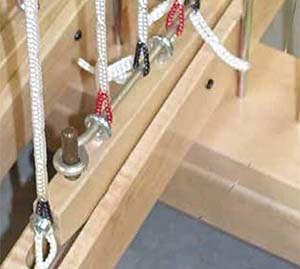
The standard Treadle Hooks lock by grabbing the first screw eye they go through and the Back-Hinge Treadles have a nylon vertical locking pin to keep them in place.
The standard treadle tie-up is shown to the right and the Back-Hingle Treadle Tie-up system is pictured to the left. |
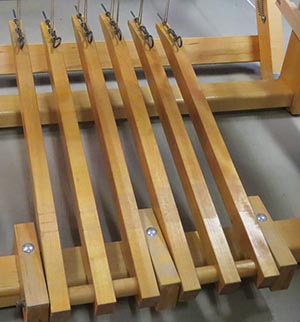
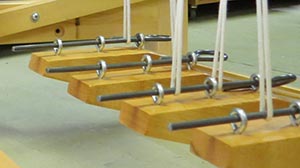 |
|
Storage on Top (CM and Jack only)
Nilus II Jack looms come with a Wooden Castle Top that provides handy storage for the weaver. When removed, the shafts can be easily lifted out to move or add heddles on a table.
The Nilus II Countermarch has a similar lid, buit it is integrated into the upper pulley unit and permanently attached. |
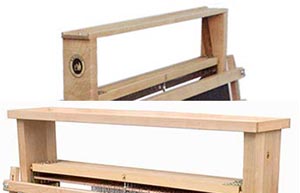 |
|
|
Shaft Frames
On a loom, the "shaft" holds a group of heddles that in turn lift and/or lower a specific set of warp threads to create the shed that the shuttle feeds the warp threads through. There are two primary ways used by loom manufacturers to construct these "shafts". Leclerc floor looms like the Nilus II use a rigid rectangular "shaft frame" and then within it, provide a mechanism to support the heddles called the Heddle Support Rod. A simpler way is to use two wooden sticks called "shaft bars" and thread heddles on to them. While greatly reducing the cost to make the loom, the "shaft bar" approach brings with it some disadvantages.
Because these shaft bars have to remain rigid while fighting the warp tension to raise or lower, they have to be thick. This thickness normally limits their use to Texsolv heddles as the wire and flat metal heddle mounting holes are too small. The wider bars also reduce the effective length of the heddles. In the Leclerc shaft frame, the narrow metal heddle support rods are thin and narrow enough to use Texsolv, Wire, Inserted Eye and/or Flat Metal heddles. The shaft frame provides the rigidity necessary and removable spring hooks are used to bind the heddle support rod to the shaft frame.
While weaving it is important that the heddles be held rigid in the shaft so that when the shaft starts to move, the heddles also begin to move. This ensures that when multiple shafts rise or fall, they move into the correct position to produce a clean shed Because the "shaft bars" are not rigidly connected like those in the shaft frame design, the loom shaft lifting/lowering mechanism is responsible for maintaining the tension on the heddles as well as tension on the mechanism. While tension of the heddles is good during weaving, too much tension can make it hard to move heddles horizontally while threading the loom. Because adjusting this tension also affects the shaft lifting/lowering mechanism (ie. loose cords can come off pulleys, rub and frey, etc.) the tension setting can be a non-optimal compromise between reliable loom operation and threading ease.
Because the Leclerc shaft frame design makes these two tension settings independent, the optimal setting can be used for the loom shaft lifting/lowering mechanism while the heddle tension can be set independently. This also means that the tension on the heddles can be greatly reduced while threading, making the process much easier!
On the Nilus II, the heddle support rods are attached to the shaft frame on either side using Shaft Frame Spring Clips. While Heddle Support Rods do flex, they are held rigid to the Shaft Frame while weaving using a pair of Heddle Support Bar Spring Hooks in the middle of the shaft frame at the top and bottom. During the threading process, releasing these hooks removes the tension from the heddles making them easy for the weaver to move side to side. The difference in tension on Texsolv heddles with and without the Spring Hooks engaged is demonstrated in this video.
Adding and removing heddles with shaft frames is also much, much easier as the Countermarch cables never need to be disconnected and/or repositioned over the pulleys as in the case of looms that use shaft bars. The Shaft Frame Spring Clips at one end of the shaft are unhooked which allows access to the ends of the heddle support rods and the heddles threaded on them.
|
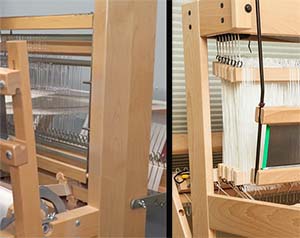
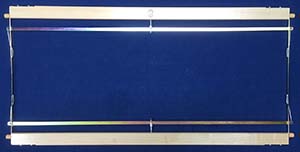

|
|
Heddle Type Flexibility
Which type of heddles are better? Texsolv or Wire Heddles? Plain Wire or Inserted Eye? While each type of heddle has their advantages and disadvantages, Leclerc has designed the Nilus II with the flexibility to let the weaver decide!
Because the Nilus II uses shaft frames instead of simpler Heddle Bars, the weaver is not forced to pick one style of heddle. With Leclerc looms they are free to pick the type they are comfortable with and can even switch later if they change their mind. This means they can choose Texsolv, Wire, Inserted Eye, Flat Steel and metal Repair Heddles and even mix all types on a single shaft if they want. They all fit! |
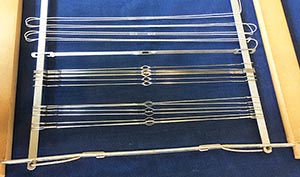 |
|
Shed Regulator (CB only)
A Shed Regulator is an attachment for Counter-Balanced looms designed to help give the weaver a perfect shed on any tie-up. It is specifically focused on improving the shed for "unbalanced" weaves like Bronson, Waffle, Double and Circular Weave where the shed is created by moving one shaft against three going the other direction.
Unbalanced weaves on a standard Counterbalance loom can sometimes result in a reduction in the size of the shed making it harder for the weaver to throw the shuttle accurately. While a balanced weave (two shafts up and two down) keeps the warp shed centered on the reed, the movement of 3 shafts in one direction tends to displace the upper and lower warp threads in that direction moving the shed itself up or down. This movement can cause a greater tension on the top or bottom warp threads as well as potentially allowing one to hit the the upper or lower edge of the reed. Either of these actions may cause the shed size to decrease.
The Leclerc Shed Regulator corrects this by automatically sensing an unbalanced distribution of the shafts and lifts or lowers the whole shaft assembly to keep the shed centered on the reed avoiding shed size restriction of the warp threads when the touch the reed edges. On balanced weaves it is not activated and as no effect on the loom. Once installed, the Shed Regulator operates automatically and the weaver can switch from balanced to unbalanced weaves without having to make adjustments to the mechanism. See a detailed description of the Shed Regulator functionality here.
To disable the Shed Regulator, the mechanism can be locked by inserting a small steel pin in the pulley at one end. This makes the loom operate like a standard Fanny Counterbalance loom. |
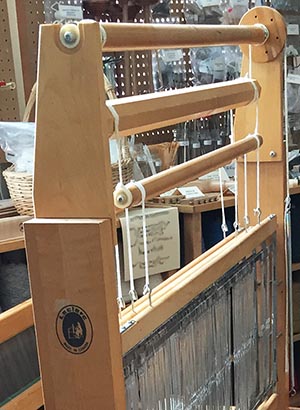
|
|
Folding Back Beam
As well as a folding back beam to increase the distance the warp threads travel, the Nilus II looms have a Folding Back Leg that increases the looms footprint depth giving it more stability. On the front hinge treadle models, these folding beam and leg fold up to greatly decrease the depth of the loom so they take up less space and make them easier to move and/or go through doorways. This can be done while the loom is warped in the middle of a project.
The Back-Hinge Treadle versions of the Nilus II can also be folded to a lesser degree but a larger number of treadle cords have to be disconnected and it takes a little more effort. |
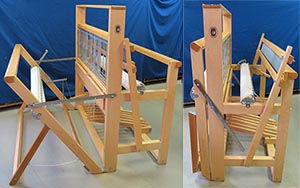
|
|
Loves to Weave Rugs!
Some types of handweaving, like weaving rugs, put a tremendous strain on the loom mechanism. To produce a good rug, the weft usually needs to be beaten so hard that the warp threads disappear and the weft that is packed in tightly increases the resulting fabric thickness. While almost any loom can be used to weave an occasional rug, some looms are not suitable for this type of weaving on a regular basis and will be damaged over time if used for this purpose. In addition, the inability to beat the weft enough and manage the warp tension will reduce the quality of the finished product.
The Nilus II heavy duty 3 1/2 inch warp and cloth beams coupled with the Apron and metal Warp Rod system can support very high uniform warp tensions across the width of the loom. The heavy duty metal double pawl system and Friction brake allow the weaver to easily apply and maintain this tension while weaving. The Counterbalance, Countermarch and Back-Hinge Treadle mechanisms available on the Nilus II looms also make it easy for the weaver to get a good shed with this kind of warp tension.
The 1 1/2" x 2 1/2" Hard Maple beams used in the frame and held together with metal bolts reinforcing the mortise and tenon joints ensure that the loom can handle the forces applied by the warp and the beating. Looms that use a lighter frame, simple screw or barrel nut fasteners, like Ikea furniture, will see deterioration over time. This is why most loom manufacturers have a more sturdy loom model for rug weavers.
One of the most important specifications to look at when comparing looms is the actual weight that helps to determine what "class" the loom is. A heavier loom usually indicates a higher degree of quality and strength and also helps with the problem of the lighter looms that "travel" across the floor or whose rocking motion cancels out the weaver's attempt to produce the heavier beating force required for rug weaving. The loom even has a Weighted Beater option to magnify the force the weaver can apply to beat the warp.
The Nilus II is an extremely flexible loom able to handle everything from fine textiles to high tension rug weaving on a continuous basis! |

|
|
No Metric Headaches
12 dents per inch equals 4.724 dents per cm -- 100 yards per pound equals 49.605 metres per kilogram -- if you are weaving 24 epi and your metric raddle has 0.5 cm spacing put 7.72 threads in each slot.
As a North American manufacturer, Leclerc recognizes that while the Metric measurement system is prevalent in other parts of the world, handweavers in North America generally practice their craft using inches, feet and yards rather than millimeters, centimeters and meters. Project planning, calculations and the warping process can be complicated enough without adding the need to convert units and adapt patterns to a different measurement system.
With that in mind, Leclerc Reeds are calibrated in dents per inch, Leclerc Raddles divide the warp into 1/2 inch groups, Sectional Warping Beams allow warp to be wound 1 or 2 inches at a time and Leclerc Counters for their Spool/Bobbin Winders and Tension Box let you know how many yards have been wound. Even the weaving widths of the various models of Nilus II are described in inches ... and as a little bonus, give you a few more inches than their metric counterparts!
Converting everything to and from metric and adapting to metric spacing on reeds and raddles may not seem like a big issue, but any little extra step when repeated over and over increases the chance of mistakes occuring and can take some of the joy out of weaving. |
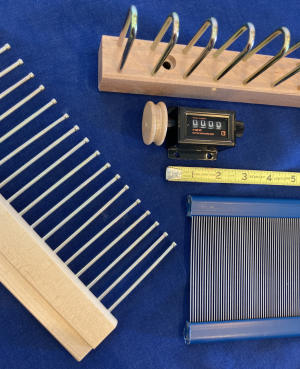
|
|
Sectional Warping
Most looms are designed to be warped by first constructing the warp on a Warping Board or Warping Mill. When it is complete, the weaver then winds the whole warp on the loom's Warp Beam.
This is also true for looms like the Nilus II, but Leclerc designs all their looms to be easily upgradeble to Sectional Warping, which is an alternative warping method that allows the weaver to wind the warp on the Warp Beam directly from yarn Spools, 1 or 2 inches of weaving width at a time. Some weavers find this approach faster than conventional warping and it offers a lot of advantages, especially with long warps or warps for very wide looms.
To facilitate Sectional Warping on their looms, Leclerc uses an octagonal Warp Beam that can be used for conventional warping with an Apron and Warp Rods or can be converted to Sectional Warping by attaching a set of 4 Sectional Beam Rakes that divide the beam up into these 1 or 2 inch sections. The Back Beam is designed to allow their Tension Box, that maintains the tension on all the warp threads being wound on, to be mounted to. A Spool Rack sitting behind the loom is used to hold the yarn tubes and/or spools that feed the warp through the Tension Box onto the Warp Beam.
This flexibility to configure the loom for either conventional or Sectional Warping allows the weaver to increase their efficiency and expertise as their weaving requirements change.
|
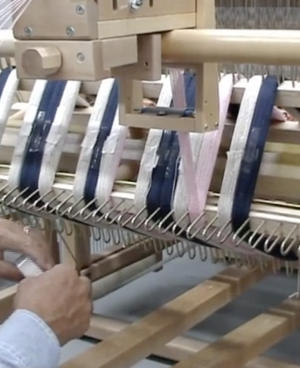
|
|
Back-Hinge Treadles (CM and Jack only)
As the number of shafts on a loom increases, the amount of force required by the weaver to create the same sized shed in the warp increases. This is because each new shaft must lift and/or lower the warp threads a little more than the previous shaft so that it's warp threads are positioned parallel to the ones attached to the other shafts (ie. producing a "clean" shed). This means that as the number of shafts increase, there is also an increase in the force required by the weaver to depress the treadles with their feet.
The most basic solution to applying more force is the lever and Leclerc has utilized that concept in the Back-Hinge Treadle version of their looms. Instead of the weaver pushing down on a short treadle mounted to the front of the loom, a longer set of treadles that pivot at the back of the loom go under the lamms and extend to the front of the loom, appearing like the foot pedals on an organ. When the weaver presses down on the extended treadles, they get a similar leverage action to help pull down the lamms. This is similar (and upside down) to the leverage provided by the extended handles that make it easy for a person to lift a heavy object in a wheelbarrow.
For those who don't have a lot of lower body strength but want to weave with more than 4 shafts, the Leclerc "back-hinged" design increases the weavers leg leverage producing a wide, clean shed with much less effort than conventional front mounted treadles. The Back-Hinge Treadles are available on both the Countermarch and Jack versions of the Nilus II and upgrades for Nilus II looms without the feature are available. See how Back-Hinge Treadles operate in the video here
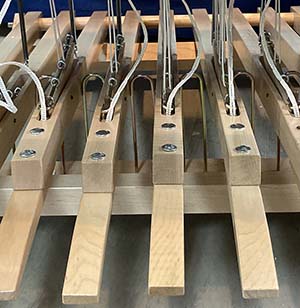
Unlike other manufacturer's looms, Leclerc's Back-Hinge Treadle design incorporates a unique "Treadle Guide" which ensures that the treadles can only move up and down. The guide is a set of inverted "U" shaped rods rising from the bottom of the loom frame which prevent horizontal movement. This eliminates the problem of treadles swinging side to side causing the weaver to have to watch where their feet go to avoid missing the treadle or having their foot slip off. With the Leclerc system the weaver can concentrate on the pattern and throwing the shuttle!
A more detailed explanation can be found here: Back-Hinge Treadle Operation
|


|
|
|
Enhanced Parallel Countermarch Design (CM only)
A Parallel Countermarch loom normally uses two sets of lamms. One set is used to raise the harnesses and the second set is used to lower them. Each Shaft has two lamms and the weaver connects each treadle to the lamm that makes the shaft rise or the one that makes it fall depending upon the pattern they are weaving. This is shown in the upper picture with the arrows indicating the movement of the cords when the treadle that lifts the shaft is depressed.
The Nilus II Countermarch loom simplifies this design by completely eliminating the second set of lamms. Instead of tieing the treadle to a lamm that lowers the shaft it is connected to the shaft itself as depressing the treadle will pull the shaft down. This simplification would be a problem in conventional Countermarch looms as attaching the tie-up cords to the "shaft bars" would interfere with the heddles moving freely over the shafts and the weaver would have to remove all the tie-up cords when threading and then re-attach them again.
Because the Nilus II uses Shaft Frames instead of "Shaft Bars", the tie-up cords used to lower shafts are connected to the shaft frame and the heddles attached to the Heddle Support Bars can freely move across the loom from one side to the other without removing the cords as shown in the lower diagram.
By removing half of the lamms from underneath the loom, the underside of the Nilus II Countermarch loom is a lot simpler, cleaner and more open, resulting in less confusion and/or tie-up mistakes.
Note that with the Parallel Countermarch design all the cables run along the sides of the loom. This eliminates the "cords through the warp" issue that conventional Countermarch loom designs have. |
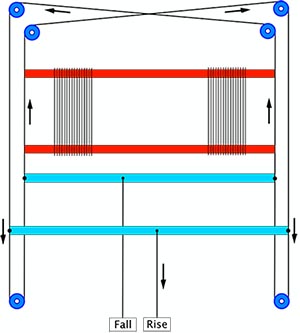
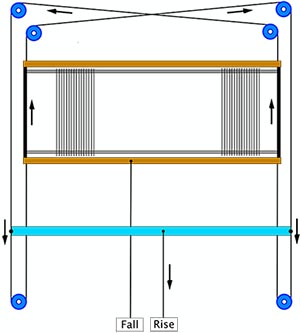 |
|
|
Cables instead of Cords (CM only)
On Countermarch looms a pulley system is used to make a shaft rise when a treadle is depressed. The pulley system in the Nilus II Countermarch is similar to other Countermarch looms instead of using low cost Texsolv loop cord, high quality wire cables are used instead.
Because cables have more of a rigidity and do not stretch like cord ensuring they will not pop out of the pulleys when the shafts are in motion. The cables also do not frey and need frequent adjustment like cord does making them more reliable and longer lasting.
The Leclerc Countermarch design also results in easier tension adjustments. The cables for each shaft can be adjusted individually by loosening or tightening the threaded fasteners where the cables attach to the lam on either side. This allows more fine adjustment than simply using the next hole in a section of loop cord. The elimination of a complete set of lams in the Leclerc single lam system also reduces the complexity of adjustment. On new looms, Leclerc presets the cables/lams in the factory and they are labeled for easily assembly.
In addition to individually setting the tension for each shaft, the tension on all the shafts can be adjusted easily using the lower pulley set on each side using a unique adjustment system. A screwdriver is used to move the whole pulley rack up or down decreasing or increasing the tension.
|

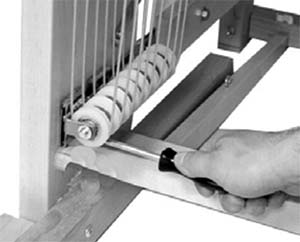 |
|
Treadle Springs (8 shaft Jack only)
In some cases on a Jack loom where a large number of treadles are attached to a shaft, the weight can apply a force that may cause the shaft to rise when not required. This is commonly referred to as a Floating Shaft and a more detailed description of the problem can be found here.
To deal with Floating Shafts, the 8 shaft versions of the Nilus II Jack loom have a set of springs on the back of the castle that can be connected to one or more treadles to counteract the downward force by applying a similar upward force. When the weaver depresses a treadle with an attached spring, the spring stretches to allow the treadle to go down. These springs are metal and much more durable then the elastics that some loom makers use for the same function. |
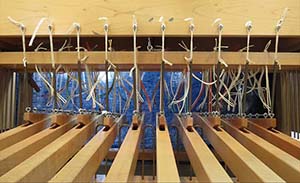 |
|
Quality Materials
Located in an area known for the production of Maple Syrup, Leclerc has access to high quality Maple hardwood which is perfect for building sturdy but beautiful loom frames. The Nilus II loom frame is made using high quality 1 1/2 by 2 1/2 inch solid Maple beams with mortise and tenon joints held together with heavy duty bolts. The bolt and square nut design enables the loom to be taken apart for moving, storage or shipment if required but allows the weaver to tighten the bolts using a single standard wrench without have to crawl under the loom or to get a second person to help.
Custom metal parts are used in places like beam ends, brake and warp tensioning mechanisms where large forces are applied. Durable non-sliding polyvinyl footpads are attached to the base of all the loom feet to reduce movement while protecting the floor. Nylon parts are only used where soft bumpers or glides are required.
A pair of heavy duty canvas aprons are provided for the warp and cloth beams to reduce loom waste by letting the weaver use as much of the warp as possible. 4 heavy duty steel rods and the cords to attach them to the aprons are included.
Leclerc also includes a Boat Shuttle, Bobbins, a Reed/Heddle Hook, Heddles and a Steel Reed with the loom as well as assembly instructions and their basics guide to weaving called Warp and Weave.
| 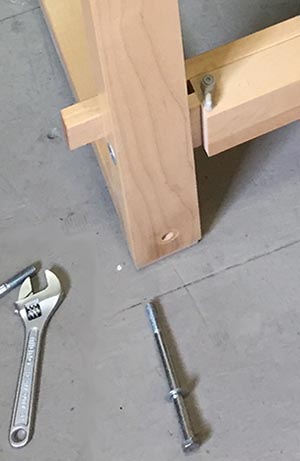
|
|
Tools and Accessories
While the most important component of handweaving is the weaving loom, a number of other tools and accessories are required to create a warp, put it on the loom and then to weave a fabric with it. There are also a number of different approaches and special requirements for different types of fabric.
As well as a wide variety of weaving looms, Leclerc produces all of the tools that are required by the handweaver. They have been designed to work together and to allow the weaver with the maximum degree of flexability.
See our Weaving Tools Checklist for a description of the warping and weaving process to understand which tools are required at each stage and why.
If you are new to weaving, this guide gives you a very quick summary of what is involved in preparing the loom and weaving the fabric. It helps ensure that you have the right tools at the start to be able to work through the process without interuptions while you source the tools you need to be able to continue. |
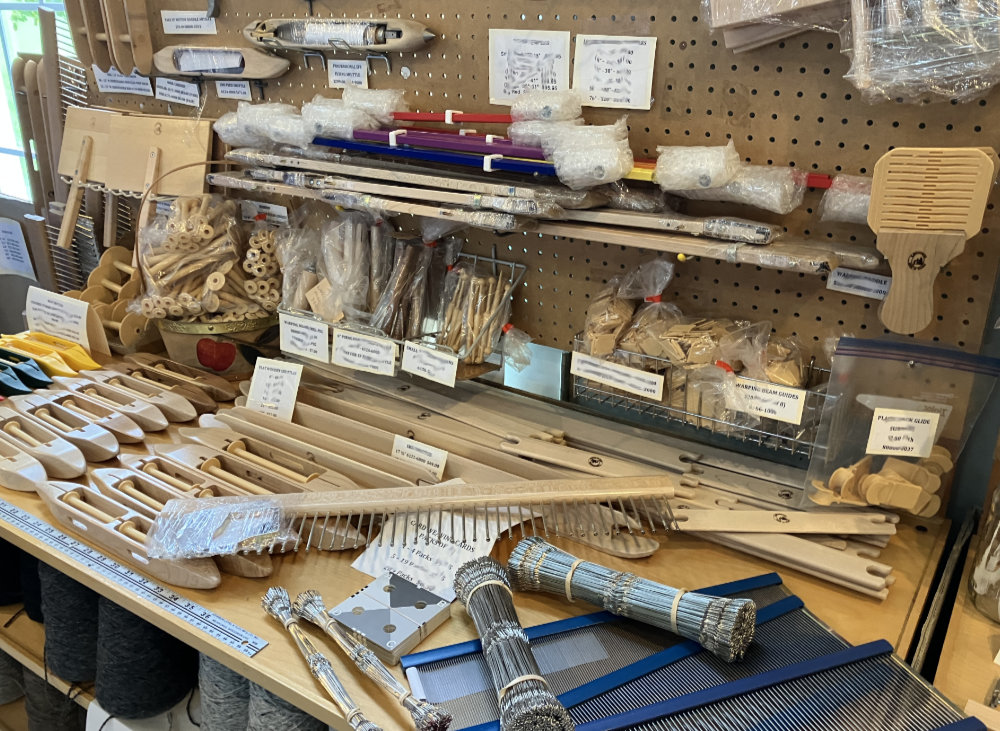 |
|
More Value for the Money
As a North American loom manufacturer, Leclerc has the benefit of not having to add a second level of distribution between themselves and their retail stores. Most of the other loom manufacturers from outside the US and Canada, as well as having to add the price of International shipping and import costs to their looms, must also include the cost of a North American importer who buys from them, imports the looms and then sells them to the dealer adding another level of markup. This results in higher prices for the loom or less money being put into the materials used to make them affecting quality.
To get their prices down, some loom manufacturers remove items that then have to be purchased by the weaver separately. Some looms actually come with half the number of heddles that are required, don't include a boat shuttle (or replace it with a low cost stick shuttle) or don't include such basics as a reed/heddle hook.
Local manufacturing also means that parts, tools and accessories for Leclerc are fast and easy to get because dealers are not waiting for the North American distributor to have enough to order to justify the "next container" shipment. |
 |
|
|
Jack |
Counterbalance |
Countermarch |
| Width |
4 Shaft |
8 Shaft |
8 Shaft with
BH Treadles |
4 Shaft |
8 Shaft |
| 36" |
1029-0000
$3,713 CDN
$3,416 US |
1029-0008
$4,263 CDN
$3,922 US |
1029-3628
$4,807 CDN
$4,422 US |
1026-0000
$3,713 CDN
$3,416 US |
1029-0018
$5,720 CDN
$5,262 US |
| 45" |
1030-0000
$3,933 CDN
$3,618 US |
1030-0008
$4,950 CDN
$4,554 US |
1030-4528
$5,176 CDN
$4,761 US |
1027-0000
$3,933 CDN
$3,618 US |
1030-0018
$6,122 CDN
$5,632 US |
| 60" |
1031-0000
$4,483 CDN
$4,124 US |
1031-0008
$5,495 CDN
$5,055 US |
1031-6028
$5,885 CDN
$5,414 US |
1028-0000
$4,483 CDN
$4,124 US |
1031-0018
$7,029 CDN
$6,467 US |
| 72" |
n/a |
n/a |
n/a |
1028-0072
$6,710 CDN
$6,173 US |
n/a |
- Email or call us at (519) 941-0736 for more information about this loom.
- Shipping to destinations within Canada or the Continental United States is included for this loom.
- Looms and accessories are guaranteed by Leclerc for one year covering defects in material and/or workmanship with parts replaced free of charge. Camilla Valley Farm extends this bringing it up to a Full 2 Year Warranty.
- Looms are shipped partially disassembled for easier handling and to avoid damage during transit. Assembly is simple with both written and video instructions included as well as the required tools.
- Looms are made of selected, well-seasoned, kiln dried Canadian hard maple or birch, except for shaft frames and a few parts that require lighter wood. Metal parts are aluminium dye cast, cast iron and steel protected by metal zinc plating.
|
Double Warp Beam
The Double Warp Beam option is a designed to assist the weaver in situations where the take-up is greater on some warp threads than on others. This ofen occurs when mixing different types or thicknesses of yarn in the warp. The differing elasticity in a long warp of this fashion makes it difficult for the weaver to get an even tension on the warp threads. With two warp beams, the different yarn can be wound on the second beam and the weaver can control the tension independently.
The extra warp beam is easy to install with brackets on the back posts of the loom, and comes with it's own friction brake which can be operated by the weaver sitting at the loom. On floor looms, this feature eliminates the need for the weaver to get up and walk around to the back of the loom to release the tension to advance the warp.
The warp threads travelling to the second beam travel over a special secondary thread beam which mounts to the main thread beam and seperates the two warp threads. This beam and the mounting brackets for it are also included. The second warp beam is removable if not in use. |
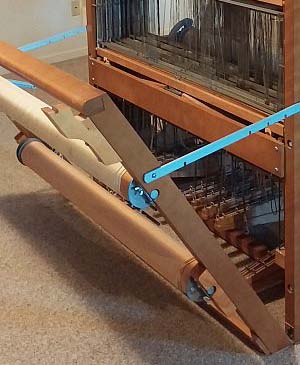 |
|
Weighted Beater
Warp Faced Weaves like Bound and Rep Weave have always presented a challenge to handweavers, especially those using wider floor looms. Rugweavers find the hard beating required to pack the weft is tiring and can cause physical strain on the weaver's wrist and arms reducing the time they can spend at the loom.
The Weighted Beater is designed for use with all versions of the Nilus II looms Identical in appearance to the standard beater Batten Handtree and Batten Sley included with the Nilus II, the Weighted Beater option adds from 4 to 13 pounds (1.8 to 5.9 kgs) to the weight of the beater assembly making it easier for the weaver to beat the weft harder.
This Weighted Beater Bar option is used to replace one or both of the horizontal Maple hardwood bars (battens) that hold the reed with similar wood battens containing hidden internal weights. The weights are designed in such a way as to not detract from the looms appearance, damage the loom or get in the way of the weaver.
Distribution of the extra weight along the length of the beater, ensures uniform packing of the weft and ensures the battens will not break under the uneven stress found when external weights are simply attached to either end of the beater. Because both Batten Handtree and Batten Sley versions are available, the amount of weight can be varied by using just one or both of these. The regular and weighted battens can be switched easily by undoing two bolts, even when the loom is warped.
|
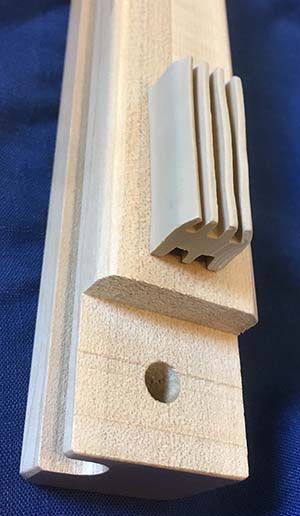 |
|
Sectional Warping Option
All Nilus II looms have a 3 1/2 inch diameter Maple Warp Beam that is pre-drilled so that a set of 4 "rakes" can be added to allow the weaver to warp the loom sectionally. These Sectional Rakes are ordered as an option to the Canvas Apron that is included standard with all Nilus II looms and come in 1 or 2 inch spacing.
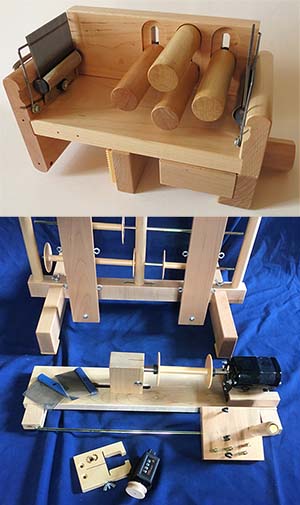
On a sectional beam, the warp can be wound up to the height of the metal clips. To allow for very, very long warps, a set of extensions can also be added to increase the beam diameter and as a result enable a much longer warp to be used. The Nilus II warp beam has been positioned with enough space above and below to allow this expansion to occur.
In addition to the sectional beam a full Sectional Warping package can be provided including a Tension Box, Warp Counter, Spool Rack, Spools and Electric Winders. Leclerc also makes Dividers, Guides and a Tension Box Extension to help with winding.
While a new Nilus II owner may not be interested in Sectional Weaving initially, it's nice to know that all the parts and tools are available from Leclerc to transition to this method of warping and that the loom is capable of being used this way. We often hear disappointment from customers who realize that this is not possible on other brands of looms! |

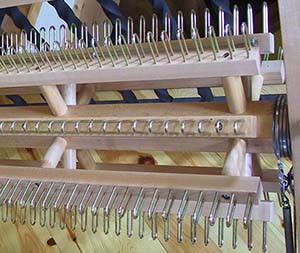 |
|
Flying Shuttle Option
All Nilus II looms can be equiped with an optional Flying Shuttle Beater. While this is an indispensable option when weaving fabric with wide widths, weavers who find the process of throwing the shuttle at narrower widths difficult may also want to consider this option. The flying shuttle can also be used to increase a weaver's pick rate.
The Flying Shuttle Beater attaches to the standard beater assembly of the Nilus II. It consists of a box to hold the shuttle at either end of the beater with a sliding "hammer". A cord is connected from each box to a wooden handle at the center of the loom that the weaver uses to move the "hammer" mechanism. By pulling on the cord, the weaver catapults the shuttle along the reed through the shed until it comes to rest in the shuttle box at the opposite end. After beating the warp and changing the shed, the process is repeated. The shuttle box at each end have a leather strap to catch the shuttle without damaging it.
This option includes a special Endfeed Flying Shuttle (EFS) with metal pointed tips that is used in the flying shuttle beater. The Flying Shuttle beater option also includes a wooden Beater Handle that attaches to the Batten Handtree (the top of beater) making it easier for the weaver to grasp the beater. The mechanism is attached to the beater Batten Sley in place of the Shuttle Race, extends out about 16 inches on either side of the loom, and can be easily installed when the weaver wishes to weave with it and removed when they want to throw the shuttle by hand. |
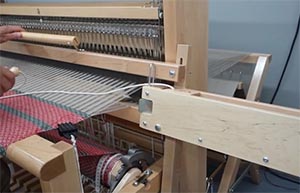
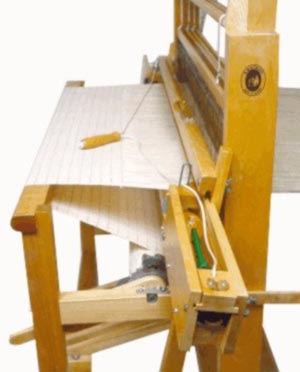 |
|
Bench Options
Leclerc provides a number of bench options. All are made with the same high quality Maple Hardwood used in the looms and are finished with a simple varnish coating to match the loom.
The basic Fixed Height Bench (top right) provides storage for tools on either side as well as a larger storage area under the hinged seat. This bench has been designed with legs that allow it to be stored out of the way underneath the front breast beam and over the treadles when not in use.
An Adjustable Bench (top left) allows the weaver to set the height using removal bolts on each side and pre-drilled holes. Storage can be added to each side using optional canvas bench bags.
The Rocking Bench (bottom pictures) is also height adjustable but has a seat that can tilt slightly for comfort. The tilting action can be disabled using a removable bolt provided with the bench. Storage can be added to each side using optional canvas bench bags. |
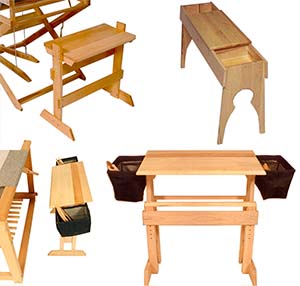 |
| LOOM OPTIONS |
ORDERING INFORMATION |
| 36" |
45" |
60" |
72" |
Heddles
(Instead of Wire) |
Texsolv
|
1024-9836T
$114 CDN
$105 US |
1024-9845T
$130 CDN
$119 US |
1024-9860T
$172 CDN
$158 US |
1029-9872T
$206 CDN
$190 US |
Inserted Eye
|
1024-9836I
$114 CDN
$105 US |
1024-9845I
$130 CDN
$119 US |
1024-9860I
$172 CDN
$158 US |
1029-9872I
$206 CDN
$190 US |
| Raddle |
6258-4000
$66.00 CDN
$61.00 US |
6258-5000
$83.00 CDN
$76.00 US |
6258-6000
$99.00 CDN
$91.00 US |
Contact
Us |
| Double Warp Beam |
6432-3000
$677 CDN
$623 US |
6432-4000
$775 CDN
$713 US |
6430-6000
$898 CDN
$826 US |
6430-7200
$984 CDN
$906 US |
| Sectional Warp Beam Kit |
1 Inch
Sections |
6441-4000
$314 CDN
$288 US |
6441-5000
$384 CDN
$349 US |
6441-6000
$484 CDN
$445 US |
6441-7200
$589 CDN
$541 US |
2 Inch
Sections |
6442-4000
$265 CDN
$244 US |
6442-5000
$294 CDN
$270 US |
6442-6000
$386 CDN
$355 US |
6442-7200
Contact Us |
| Flying Shuttle Beater |
6471-4000
$1,380 CDN
$1,270 US |
6471-5000
$1,380 CDN
$1,270 US |
6471-6000
$1,495 CDN
$1,375 US |
6471-6072
$1,733 CDN
$1,594 US |
| Weighted Beater Bar |
Top |
1560-3600
$161 CDN
$148 US |
1560-4500
$182 CDN
$167 US |
1560-6000
$228 CDN
$218 US |
1560-7200
$305 CDN
$292 US |
| Bottom |
1570-3600
$213 CDN
$176 US |
1570-4500
$242 CDN
$222 US |
1570-6000
$299 CDN
$275 US |
1570-7200
$400 CDN
$368 US |
| Clip Temple System |
6146-0000
$105 CDN
$96 US |
Rocking Loom Bench
(Height Adjustable between 21 and 26 3/4") |
6384-7000
$624 CDN
$574 US |
Open Ended Loom Bench
(26" High with open ends for storage) |
6384-4000
$788 CDN
$725 US |













